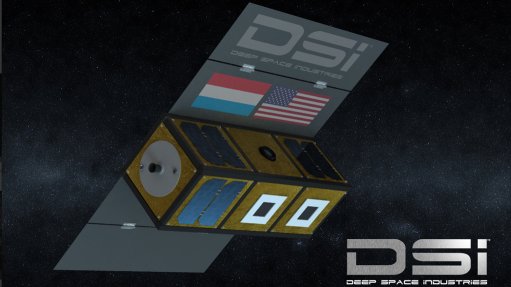
A conceptual image of Deep Space Industries' Prospector X prototype satelite
Photo by: Bryan Versteeg/Deep Space Industries
VANCOUVER (miningweekly.com) – Deep Space Industries (DSI) has entered the race to launch spacecraft that will identify and mine near-earth asteroids, in the hope of establishing a new space economy.
The California-based company on Tuesday announced plans to fly the world’s first commercial interplanetary mining mission. Its Prospector-1 would coincide with an asteroid near earth and investigate it to determine its value as a source of space resources.
DSI explained that it planned to undertake two Prospector missions, the first being Prospector X, an experimental mission to low-earth orbit that would test key technologies needed for low-cost space exploration. It was scheduled to launch in 2017. Prospector-1 would follow before the end of this decade and travel beyond the earth’s orbit to start the first space mining exploration mission, advised the company, which had partnered with the Luxembourg government.
“DSI’s Prospector missions will usher in a new era of low-cost space exploration. DSI is developing Prospector-1 both for its own asteroid mining ambitions, as well as to bring an extremely low-cost, yet high-performance exploration capability to the market. We hope to enable both existing and new public and private organisations to explore the inner solar system using this affordable platform,” stated chief engineer Grant Bonin.
According to DSI, Prospector-1 is a small spacecraft, weighing in at 50 kg when fuelled, that strikes the ideal balance between cost and performance. Further to radiation-tolerant payloads and avionics, all DSI spacecraft use the Comet water propulsion system, which expels superheated water vapour to generate thrust. Water would be the first asteroid mining product, so the ability to use water as propellant would provide future DSI spacecraft with the ability to refuel in space.
The asteroid that Prospector-1 lands on will be chosen from a group of top candidates, selected by the asteroid experts at DSI. Once it arrives, Prospector-1 will map the surface and the subsurface of the asteroid, taking visual and infrared imagery and mapping water content. Once this is complete, the spacecraft will attempt to land on the asteroid, measuring geophysical characteristics, explained DSI.
“During the next decade, we will begin the harvest of space resources from asteroids. We are changing the paradigm of business operations in space, from one where our customers carry everything with them, to one in which the supplies they need are waiting for them when they get there,” explained DSI CEO Daniel Faber.
The Prospector missions will be aimed at demonstrating DSI’s low-cost, high-performance approach to space exploration. The prospector platform will soon be available to government and commercial explorers interested in developing a low-cost mission of their own.
SPACE RACE
DSI rival Planetary Resources successfully deployed its first spacecraft into orbit from the International Space Station in July last year. A larger spacecraft, the Arkyd-6A, is being prepared for launch later this year and will observe earth in infrared wavelengths in anticipation of asteroid prospecting.
However, the prospective asteroid miner has in the meantime turned its gaze back to earth to focus on deploying and operating Ceres, an advanced earth observation business featuring the first commercial infrared and hyperspectral sensor platform, which would be harnessed to better understand and manage humanity’s natural resources.
The Redmond, Washington-based firm advised that earth observation would from now on be another aspect of its operations, complementing its prospecting and mining of asteroids.
Planetary Resources considers asteroid mining a first and key step to the eventual colonisation and commercialisation of space. Planetary will first aim for the low-hanging fruit – the near-earth asteroids of which some 13 000 have been identified to date. The company has estimated that these could contain up to 42-trillion tons of resources, including nickel, iron-ore and precious metals at much higher grades than those found on Earth.
In a previous interview with Mining Weekly Online, chief engineer and CEO Chris Lewicki noted that many of these asteroids contained significant amounts of water which, in space, could be split relatively easily into its constituent molecules to make rocket fuel.